You’ve heard of friendship bracelets… but what about a friendship quilt? Whether it’s for a back-to-school community builder, a social studies tie-in, or just a feel-good class project, creating a friendship quilt is a meaningful way to celebrate connection and belonging. First, we’ll explore the history and symbolism behind quilts—especially friendship quilts—and share a hands-on activity that brings students together, stitch by stitch (no sewing required). Bonus: You’ll get plenty of additional resources for weaving quilts into your lessons, too.
If you’d like to skip right to the project, click here.
Why Are Quilts Important?
My grandmother, Ma, made each of her children and grandchildren several quilts throughout our lives— Christmas quilts, quilts for graduation, quilts made of old blue jeans, quilts made from material with patterns representing hobbies or interests, etc. She wasn’t a show quilter or professional, but she would spend hours choosing material, measuring, piecing patterns, pinning, and sewing. My ever-patient grandfather, Pa, was called upon for all the meticulous cutting that my grandmother did not particularly enjoy. She would always include a little cross-stitched patch with our name, “Love, Ma,” and the date, which is my favorite part. I will cherish and keep these quilts forever!
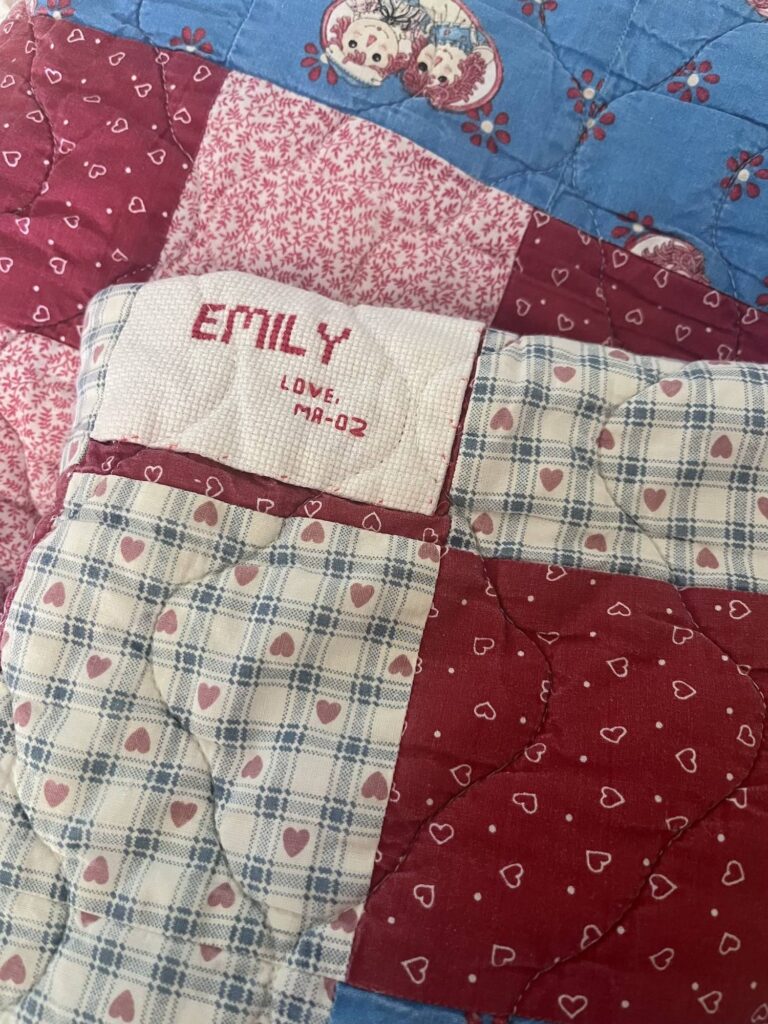
As a young girl, my mom saved up all her extra money over time to get me an American Girl Doll, the absolute prized possession of so many children in the late 80s and 90s. I had wanted one for a long time! And my first experience with quilting myself was when my Ma helped me sew a small quilt to cover my American Girl Doll with at night, you know, while she was sleeping. I’ll never forget sitting with her, talking, and learning about sewing and how to cut and measure the squares. Now, this is just a bit of my personal experience with quilts and quilting, but it is a very teeny tiny reflection of how quilting is passed down and how relational it can be.
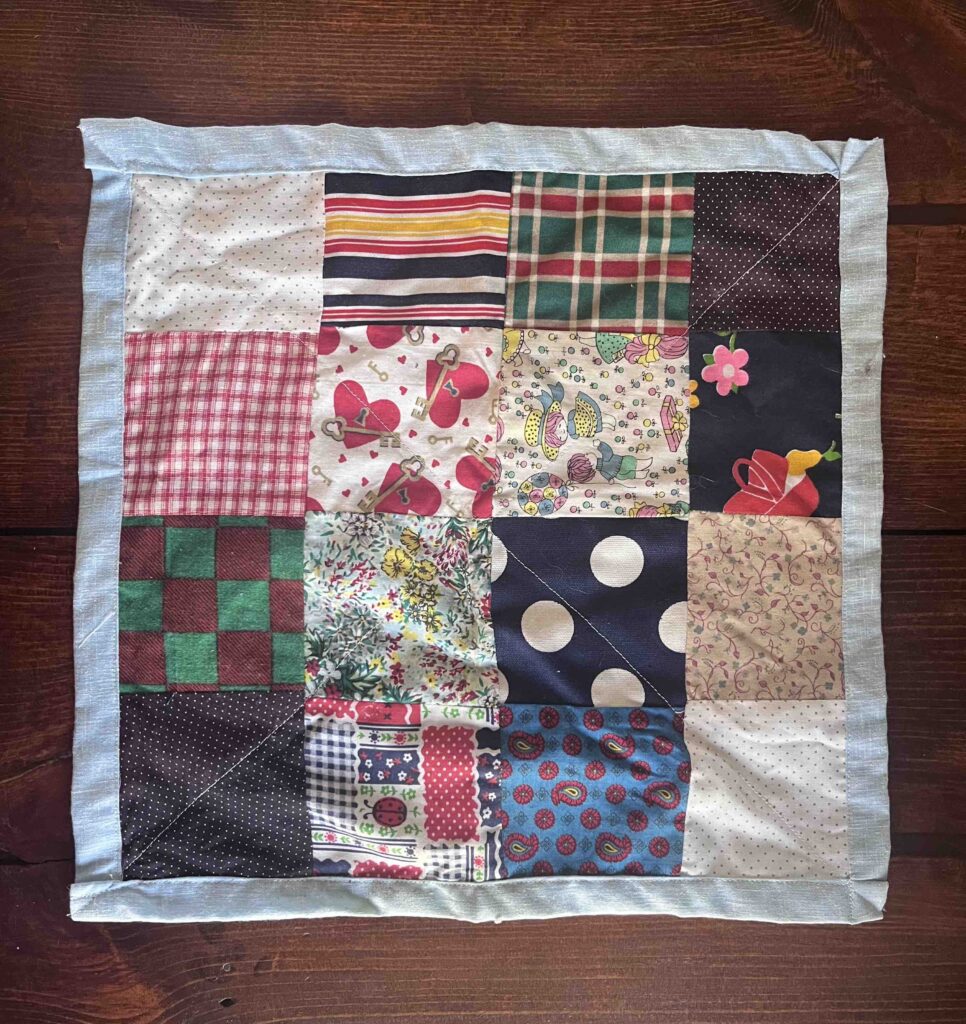
Quilting is a skilled art passed from generation to generation. It spans cultures and peoples. Quilts require mathematical skills, creativity, patience, focus, and precision. They were, and are still, handmade and given to commemorate special occasions— a form of both artistic expression and documentation. Additionally, quilting bees and circles were a way for women to socialize and spend time together. It was at one time a very community-driven and relational art, and in some areas and cultures, this is still very much the case. Over time, there have been many different types of quilts and quilt patterns, like Double Wedding Ring, Patchwork, Log Cabin, Crazy Quilts, and more, but one of my absolute favorites is the friendship quilt.
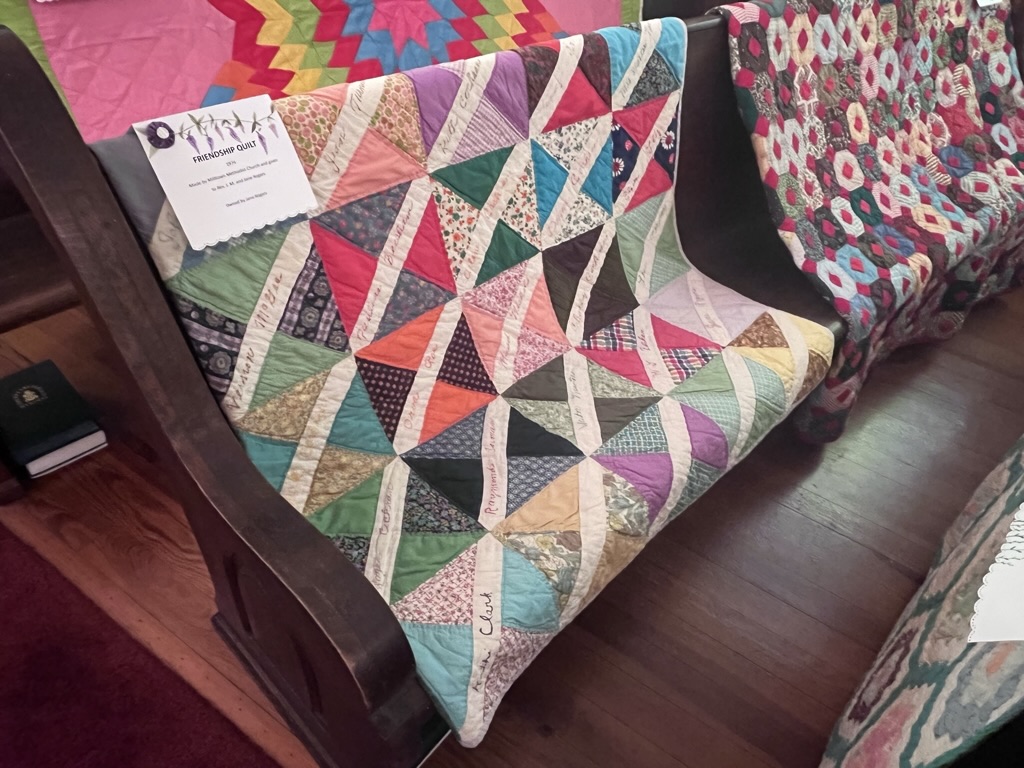
Note the signatures of the ladies who made each square on the white diagonal pieces.
What Is a Friendship Quilt?
Friendship quilts are a traditional form of quilt made collaboratively by a group of friends or even family. They have a rich history and special significance in American culture and are some of the very few quilts that have names associated with them. They sometimes even included dates, special messages, and addresses as well, making them very special. Originating in the Philadelphia, Baltimore, and New Jersey areas, the tradition of friendship quilts spread to become more popular in areas west, north, and south. The form and patterns of friendship quilts have changed and adapted over time.
The Making of a Friendship Quilt
A friendship quilt is made by having each member of a friendship group contribute a quilt block that they have sewn. The quilt blocks are then assembled and sewn together into a single quilt. Each block is unique and represents the individual who made it. The blocks often contain personalized decorative elements like embroidered names, initials, symbols, dates, or short messages. Names, initials, and messages may be hand-sewn, written in ink, or even stamped.
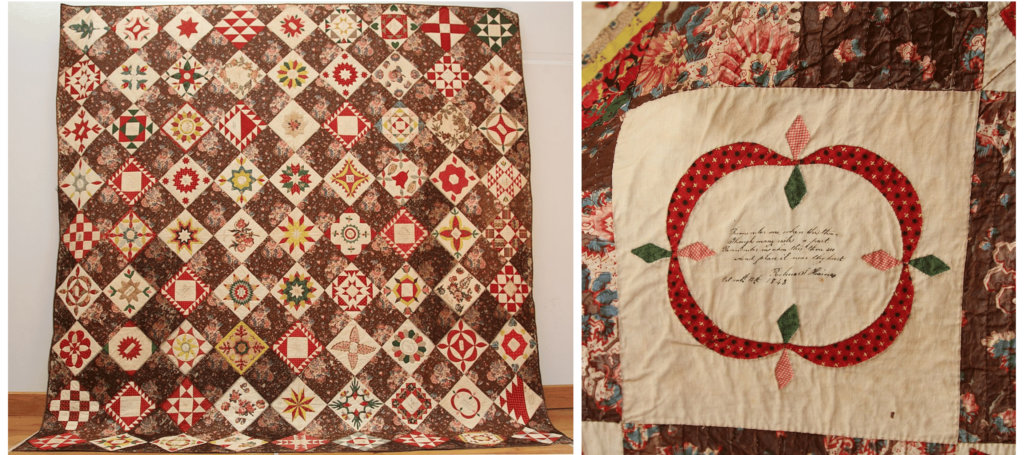
Quaker Album or Friendship quilt made in Burlington County, New Jersey in 1843.
The Meaning of the Friendship Quilt
Friendship quilts first became popular in the early 1800s. Groups of women would gather together for quilting bees as a social occasion. They would work collaboratively on quilts for members of their community while also using it as a chance to talk and build friendships. The quilt they produced represented the bonds of sisterhood, community, and connection between those who worked on it.
The History of the Friendship Quilt
These quilts were especially meaningful on the American frontier. As women headed west from the east coast with their families, the quilts served as a record of the long journey. They also helped pioneer women maintain social networks in isolated areas without extended family nearby. The quilts connected them to friends and home.
Over time, friendship quilts began to mark major life events like births, deaths, weddings, or relocations. They took on special significance as historical records of women’s lives and friendships. The communal creative process represents shared experience and cooperation.
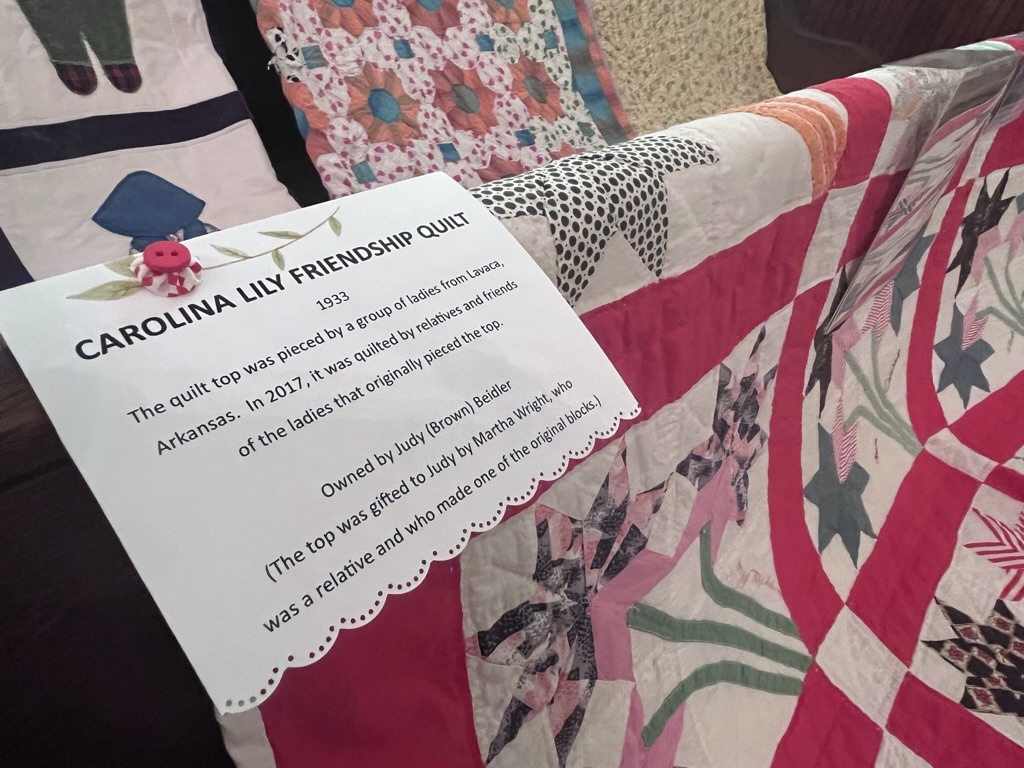
Today, many antique friendship quilts are preserved in museums. They are valued as culturally important folk art celebrating relationships between women and documenting American history through intricate stitches and patches.
Making a Class Friendship Quilt
If you’re looking for a class project, why not piece together a paper friendship quilt with students that represents your classroom community? Each student can make a quilt block to contribute to the class friendship quilt and sign their name on it. A quilt block is a unit (in this activity it will be a square) that is sewn together to make up a full quilt.
For this activity, students will each construct their own quilt blocks out of paper. Essentially, they will:
- Cut the shapes out of a quilt block pattern.
- Trace the shapes onto a variety of colorful, patterned paper.
- Cut those colorful shapes out.
- Glue them onto a plain white square made of posterboard, card stock, or paper.
- Admire their created quilt blocks!
Here is what a finished quilt block made by a student might look like. This was a student-created pattern, meaning the student did not follow a quilt block pattern but made up their own using shapes.
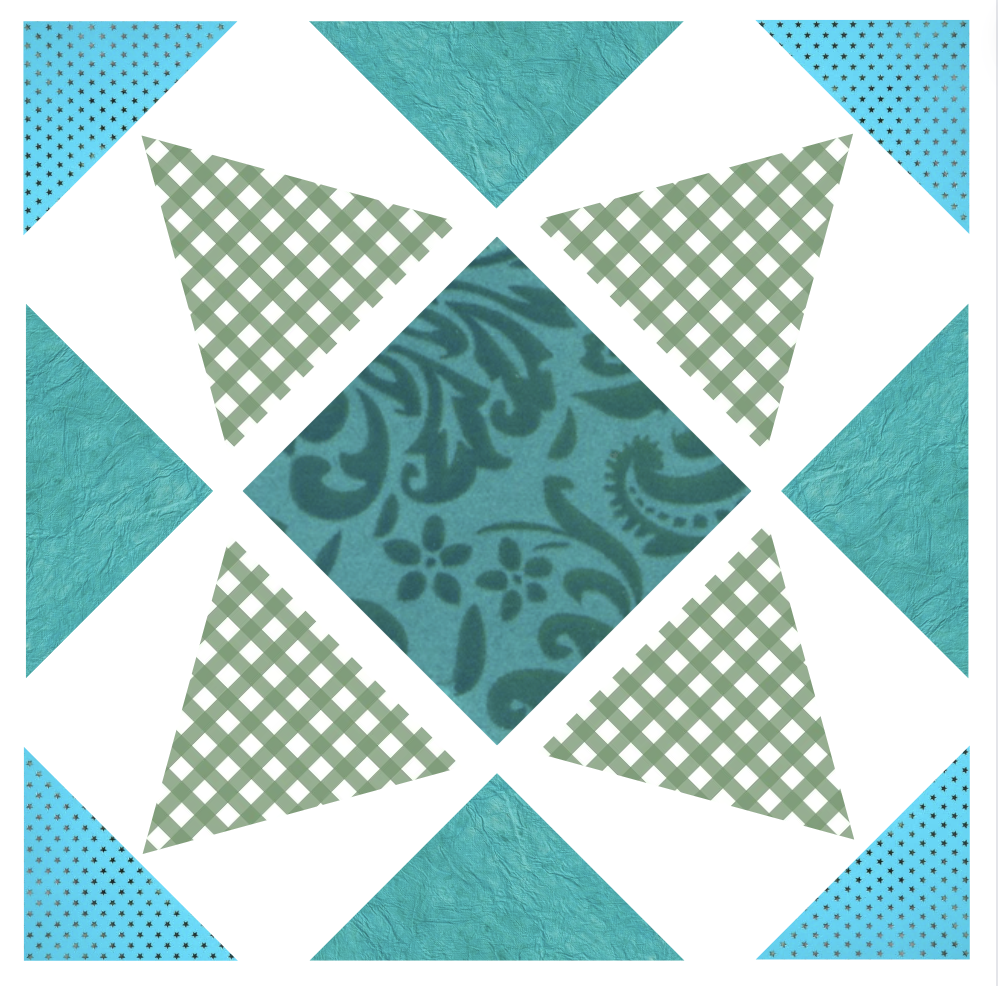
Here is a list of materials and a few suggestions for choosing quilt block patterns. It can really be as simple or complex as you’d like it to be!
Materials List:
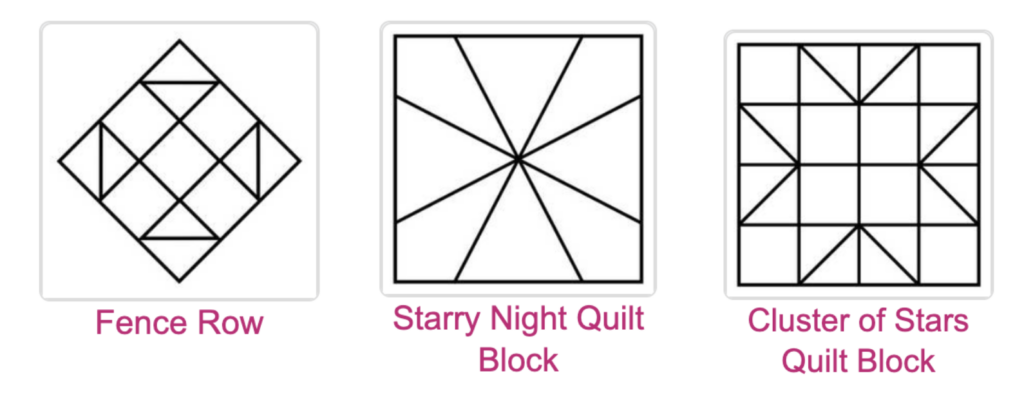
- Plain white square (6×6, 9×9, or 12×12) made of posterboard, cardstock, or paper.
- Quilt Block Patterns: When it comes to patterns, I’ve listed a few approaches for you to choose from. Choose which option works best for you and your students.
- Pattern Option 1: Preselect one quilt block pattern for all students to use as their template. Distribute a copy of the pattern to each student in the correct size.
- Pattern Option 2: Preselect 3-4 quilt block patterns for students to choose from for their template. Distribute a copy of the pattern to each student in the correct size.
- Freeform Option: Have students create their own special patterns using traceable shapes, rulers, or freeform drawing!
- Digital Option: Have students design their blocks online using line tools, shapes, and elements in Google Slides, Canva, Adobe Express, or similar tools.
- Paper: Scrapbook paper, wrapping paper, and colorful paper with a pattern will work great. Some solid paper would also be good to incorporate. Note: For younger students, sticking with just solids may be best if you’re having them follow a quilt block pattern.
- Crayons, Markers, Colored Pencils: If you opt for students to create their own patterns on white paper, you’ll need plenty of coloring options!
- Scissors: Regular scissors or scissors with fun edges are both great.
- Glue: You can use glue sticks, from a bottle, or Mod Podge (I prefer using old paint brushes with liquid glue).
- Ink: Sharpies or paint/gel pens are great.
- Ruler: Measuring to make sure the squares and pieces are straight and the correct size will be important!
- Pencil: Mistakes will happen. Using a pencil when measuring and tracing will be helpful.
This can be just a fun arts and crafts activity for students to celebrate Palentine’s (or Valentine’s) Day. But you can also incorporate some math and history standards as well!
Suggested Lesson Plan Structure
This is an adaptable lesson that can be completed in a short period or span multiple periods. Feel free to adapt it to meet your needs and desired outcomes! For example, if you’d like the activity to go more quickly, you can provide precut shapes for students to glue (no cutting or tracing involved) or have them design squares in Canva to be printed. If you’d like to take more time, incorporate some of the math ideas and history of friendship quilts.
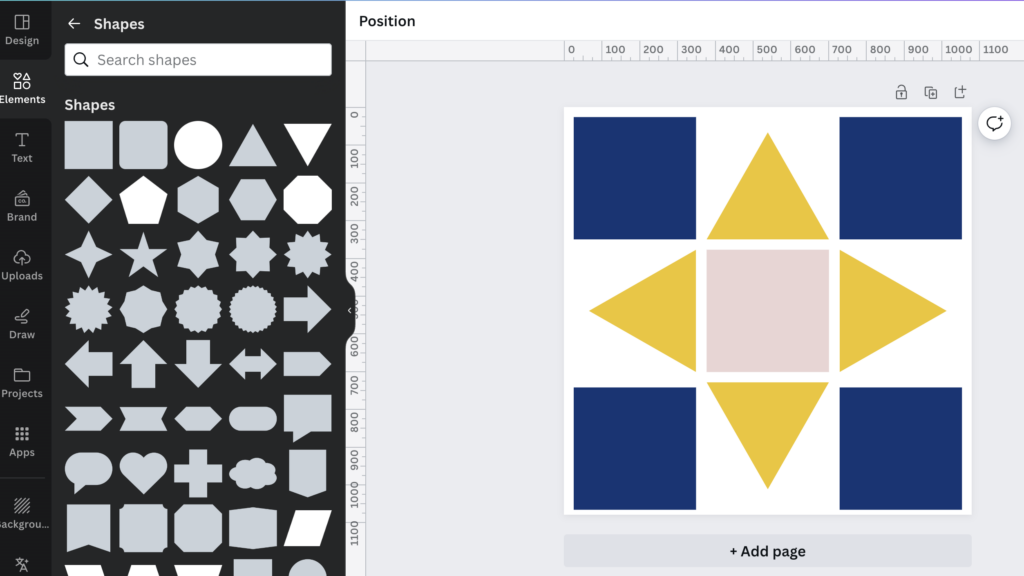
Introduction:
Introduce students to the concept and history of the friendship quilt. Look at pictures of different friendship quilts and talk about what students notice. How do students imagine these quilts were made? What do friendship quilts tell us? Why might they be important in a community or group of people? Read an article or book as a class and discuss (see resource list). Explain that students will be making a paper friendship quilt as a class. Each student will contribute one square, and when they are all put together, it will create a full-sized paper quilt.
Activity:
Explain and briefly demonstrate how:
- Students will either choose a block pattern or create their own block pattern for their square. Look at some examples of quilt block patterns together, if appropriate.
- Explain and demonstrate how students will cut out the shapes from their printed block pattern and trace them onto the colorful paper of their choice.
- Then, show students how to cut the traced shapes from their colorful paper and position them on their white squares. They should lay out their shapes to match their block pattern.
- Demonstrate how to glue the pieces of the block to the plain white square.
- Show students an example of a finished square. You could make your square in advance to show them!
- Distribute the quilt block pattern you chose, have students choose a pattern, or let them create their own patterns.
- Pass out the plain white squares (whatever size you choose, 6″, 9″, 12,” etc.).
- Have fun cutting, tracing, gluing, and signing squares!
- Hang students’ blocks individually on the wall, grouping them together to create a visual quilt. Or create your quilt by gluing the squares together before hanging the full quilt on the wall.
Ideas for Incorporating Math Skills
After you determine how big you would like your overall quilt to be, here are some math skills you can work with students on before and during the activity:
- Determine the perimeter and area of the full quilt.
- How many rows and columns should the quilt have in order for each student to have the same size square? Calculate how big each individual student’s square should be.
- Identify the shapes within your block.
- Explore symmetry by creating block patterns with symmetrical sides.
- Measure and record the angles of the shapes within your block.
- If designing your own pattern, use a ruler to draw out and measure shapes in your pattern. Record your measurements.
Lesson Plans and Resources about Quilts
- History in Quilts (lesson plan) by EDSITEment!
- Stories in Quilts (lesson plan) by EDSITEment!
- Friendship Quilts (article) by World Quilts, The American Story
- Sweet Clara and the Freedom Quilt (book) by Deborah Hopkinson
- The Friendship Quilt (lesson plan) by Carmel Mountain Preschool
- Friendship Quilts: The Gift of Remembrance (article) by the Journal of Antiques and Collectibles
- The Keeping Quilt (book) by Patricia Polacco
- The Keeping Quilt (supporting materials) by Reading is Fundamental
- Quilt Squares (lesson plan) by Craft Revival: A Project of Hunter Library Digital Initiatives at Western Carolina University
- Quilts and the Underground Railroad (lesson plan) by Craft Revival: A Project of Hunter Library Digital Initiatives at Western Carolina University
- I Sang You Down from the Stars (book) by Tasha Spillett-Sumner
- International Quilt Museum Educational Resources
- The All-Together Quilt (book) by Lizzy Rockwell
Besides friendship quilts, there are many other varieties of quilts, each with their own significance and meaning. I hope you’ll enjoy exploring some stories, history, resources, and information on the great personal and historical significance quilts hold. And if you try making a friendship quilt with your students, please leave us a comment and link to a photo! We’d love to see your class’s friendship quilt.

